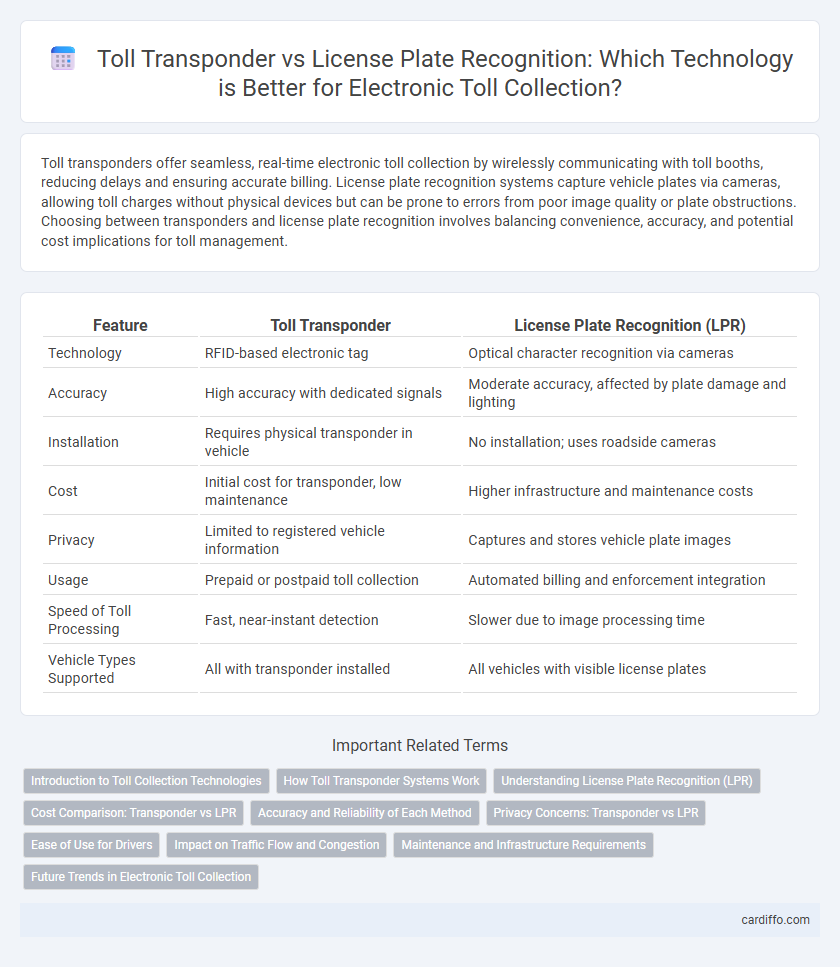Toll transponders offer seamless, real-time electronic toll collection by wirelessly communicating with toll booths, reducing delays and ensuring accurate billing. License plate recognition systems capture vehicle plates via cameras, allowing toll charges without physical devices but can be prone to errors from poor image quality or plate obstructions. Choosing between transponders and license plate recognition involves balancing convenience, accuracy, and potential cost implications for toll management.
Table of Comparison
| Feature | Toll Transponder | License Plate Recognition (LPR) |
|---|---|---|
| Technology | RFID-based electronic tag | Optical character recognition via cameras |
| Accuracy | High accuracy with dedicated signals | Moderate accuracy, affected by plate damage and lighting |
| Installation | Requires physical transponder in vehicle | No installation; uses roadside cameras |
| Cost | Initial cost for transponder, low maintenance | Higher infrastructure and maintenance costs |
| Privacy | Limited to registered vehicle information | Captures and stores vehicle plate images |
| Usage | Prepaid or postpaid toll collection | Automated billing and enforcement integration |
| Speed of Toll Processing | Fast, near-instant detection | Slower due to image processing time |
| Vehicle Types Supported | All with transponder installed | All vehicles with visible license plates |
Introduction to Toll Collection Technologies
Toll collection technologies have advanced from manual toll booths to automated systems such as toll transponders and license plate recognition (LPR). Toll transponders, like RFID devices, enable real-time vehicle identification and faster processing at toll points, reducing congestion and enhancing traffic flow. License plate recognition uses high-resolution cameras and optical character recognition to capture vehicle information, permitting toll charges without physical devices, but may face challenges in accuracy due to environmental factors.
How Toll Transponder Systems Work
Toll transponder systems work by using radio-frequency identification (RFID) technology to communicate between the transponder device mounted in a vehicle and toll plaza readers. When a vehicle passes through a toll point, the transponder transmits a unique identification code to the reader, which then deducts the appropriate toll amount from the driver's prepaid account. This system allows for faster, more accurate toll collection compared to license plate recognition, which relies on cameras and optical character recognition to capture and process vehicle registration details.
Understanding License Plate Recognition (LPR)
License Plate Recognition (LPR) technology captures and analyzes vehicle license plate images using advanced cameras and optical character recognition (OCR) software to facilitate toll collection. Unlike toll transponders that require active signal communication, LPR enables seamless vehicle identification without additional hardware, supporting automatic billing and enforcement. LPR systems enhance toll operations by reducing infrastructure costs and improving accuracy in tracking non-transponder users.
Cost Comparison: Transponder vs LPR
Toll transponders generally require an upfront cost for device purchase and installation, but offer lower recurring expenses through discounted toll rates and reduced transaction fees. License Plate Recognition (LPR) systems eliminate the need for physical devices, relying on camera infrastructure and software, which can involve higher maintenance and processing costs due to data management and violations enforcement. Overall, transponders tend to be more cost-effective for frequent users, while LPR provides flexibility with variable costs tied to system operations and enforcement.
Accuracy and Reliability of Each Method
Toll transponders offer high accuracy by directly transmitting vehicle identification data, minimizing errors caused by environmental factors or obstruction. License plate recognition technology relies on camera systems and optical character recognition, which can be less reliable due to poor lighting, weather conditions, or dirty plates. Overall, transponders provide more consistent reliability and faster processing compared to license plate recognition systems.
Privacy Concerns: Transponder vs LPR
Toll transponders store unique vehicle identifiers directly linked to individual accounts, raising concerns about data security and unauthorized tracking. License Plate Recognition (LPR) systems capture and store images of license plates, potentially exposing location history and enabling broader surveillance. Both methods require stringent data protection measures to address privacy risks associated with continuous monitoring and data retention.
Ease of Use for Drivers
Toll transponders offer seamless, hands-free toll payments by automatically communicating with toll booths, reducing the need for drivers to stop or slow down. License plate recognition systems rely on cameras capturing vehicle plates, which can cause delays or errors if plates are dirty or obscured. Transponders enhance ease of use by providing faster, more reliable transactions, minimizing driver effort and improving traffic flow at toll points.
Impact on Traffic Flow and Congestion
Toll transponders enable faster, seamless toll collection by allowing vehicles to pass through toll points without stopping, significantly reducing traffic congestion and improving overall traffic flow. License plate recognition systems rely on image processing, which can introduce delays due to slower vehicle identification and the need for manual verification in case of recognition errors. Consequently, toll transponders are more effective in minimizing bottlenecks and optimizing highway throughput during peak traffic hours.
Maintenance and Infrastructure Requirements
Toll transponders require dedicated roadside infrastructure such as antennas and readers that need regular maintenance to ensure signal accuracy and system reliability. License plate recognition (LPR) systems depend heavily on high-resolution cameras and advanced image processing software, which must be calibrated and updated frequently to maintain optimal performance. The ongoing upkeep of LPR systems often involves higher operational costs due to software upgrades and the need for robust data storage solutions compared to the simpler hardware maintenance of transponder-based setups.
Future Trends in Electronic Toll Collection
Future trends in electronic toll collection emphasize increased adoption of license plate recognition (LPR) technology, leveraging advanced AI and machine learning algorithms for accurate vehicle identification without the need for physical transponders. Integration of LPR with cloud-based platforms enhances real-time data processing and dynamic pricing models, promoting seamless toll payments and reduced congestion. The shift towards contactless tolling systems supports smart city initiatives, improves traffic flow, and reduces operational costs for toll authorities.
Toll transponder vs license plate recognition Infographic

 cardiffo.com
cardiffo.com